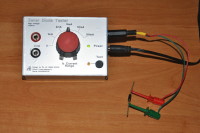Zener Diode Tester

In this page I present my approach to building a Zener diode tester. There are of course several DIY versions on the internet, but I have a few requirements... I am often confronted with switching power supplies in which Zener diodes are used to stabilize certain voltages and the worst part is that too often their marking is illegible or almost non-existent. That's the whole point of this instrument.
There are of course several DIY versions on the internet, but I have a few requirements...
I am often confronted with switching power supplies in which Zener diodes are used to stabilize certain voltages and the worst part is that too often their marking is illegible or almost non-existent. That's the whole point of this instrument.
Most of the assemblies that I have seen on the Internet do not allow testing Zener diodes having a reverse voltage threshold greater than 30V. However, I have already been confronted with 33V or even 36V Zener diodes. To check these latest models it is therefore necessary to be able to exceed this threshold of 30V.
In an article published in the Elektor magazine in March 2010, such a device is presented, even making it possible to test diodes up to 200V, but it mainly uses two transformers (three if we consider the one reserved for the polarization of the small integrated panel voltmeter...). I have never been confronted with such high values which do not interest me in this project, and on the other hand I did not want to exceed the 48V threshold for simple safety reasons. The use in the previously cited article of a current source does not leave me indifferent, and I took inspiration from it here.
However, I draw your attention to the fact that this instrument is not intended to control a Zener diode on a circuit; it must be removed before any measurement.
My requirements and/or constraints
- use as many recovery components as possible, mainly the inductance L1 (model retained of 4.7 mH)
- no transformer, power supply is provided by a small power supply. switching DC12V / 1A
- use of an existing box (sorry, no ref because it's an old model around 30 years old...) in my drawers, aluminium model, dimensions (L x W x H): 100 x 70 x 40 mm
- use the principle of a current source offering several measurement calibers
- do not exceed the threshold of 48V, voltage available on the two banana sockets in the absence of a diode to test (unless the switch is in the '0' position...)But how can I generate the potential difference necessary for the measurement without using a transformer, and all with a maximum of components (
The oscillator and its chopper circuit
As soon as the power is turned on via the 12V socket (I have not provided a general switch...) the oscillator organized around the NE555 starts at a frequency of approximately 1.4 KHz, the chopper circuit made up of transistor T1 (IRF740 - MOSFET Channel N) and inductance L1 (4.7 mH) only starting to cut out when the push button is pressed. The advantage of this functionality is to avoid overheating in the inductor as much as possible. The operating frequency was chosen following several manipulations with my function generator in order to obtain a voltage greater than +40V on the cathode of the Schottky diode D1 (SB120). Resistor R6 (47 kΩ) is used to discharge the filter capacitor C3 (1 µF/100V).
The push button only powers the chopper circuit when it is pressed, the oscillator circuit remaining continuously powered. The reason is that in view of the oscillogram the potential difference of 1VC/C present on resistor R5 (1 Ω) implies a current of 1A (we are in the presence of an impulse regime here. ..) for a maximum power of 1W. The trace CH I corresponds to the signal recorded on the drain of the transistor, while the trace CH II is that of its source in relation to ground, and therefore of the signal absorbed by resistor R5. The progressive rise corresponds to the accumulation of energy in the inductance during conduction (ton=294 µs) of the MOSFET transistor.
The inductor I selected comes from an old power supply. switching and I do not know its characteristics apart from its value indicated on the body (small problem during my manipulations, I had to repair it, a broken pin is the reason for this yellow sheath...). It reaches more than 40°C quite quickly, which actually suggests that it is not capable of working for a long time under this high current. We should probably prefer an inductor like the Murata 1447509C model for example, but the dimensions of my PCB do not allow it to be placed there, so we would have to review everything... :-(
However, the measurement time being relatively short, a few seconds at most, this remains acceptable for sporadic use.
Another approach would be to use an inductor of 15 µH for example, and modify the oscillator circuit to reach a frequency of around 50 KHz... why not... the one I have in stock did not accept operate in such a system...
The constant current source
A constant current source maintains a predefined current (here depending on the resistors R9 to R13) through a load composed of the Zener to be tested (D.U.T) in series with the diode D2 which only serves as protection against short circuits, whatever its value. Thus if we consider the base current of T2 as negligible compared to its emitter current, we can estimate that the collector current is almost equal to the current circulating in the emitter junction.
This current source is composed of transistor T2 (BD140) in 'common base' mode, Zener diode ZD1 (BZX55C 4.7V) and resistor R8 (2.2 kΩ) polarizing its base. A rotary switch allows you to select a resistance from the 5 available in order to choose a current for the measuring circuit. The values of these resistors have been calculated in order to obtain the proposed currents, namely 1 mA / 2 mA / 5 mA / 10 mA and 50 mA. The method for calculating these values is simply as follows:
I = (VZD1 - VBE) / Emitter resistance which gives us with the standard values of the E24 series:
I = (VZD1 - VBE) / R9 = (4.7V - 0.6V) / 3900 Ω = 1.05 mA
I = (VZD1 - VBE) / R10 = (4.7V - 0.6V) / 2000 Ω = 2.05 mA
I = (VZD1 - VBE) / R11 = (4.7V - 0.6V) / 820 Ω = 5.00 mA
I = (VZD1 - VBE) / R12 = (4.7V - 0.6V) / 390 Ω = 10.51 mA
I = (VZD1 - VBE) / R13 = (4.7V - 0.6V) / 82 Ω = 50.00 mA
To check the correct operation of this current source, it is possible to place for example a 100 Ω / 1% resistor in place of a Zener to be tested, measuring its potential difference must confirm the accuracy of the currents indicated above.
The total consumption of the instrument during a measurement is 165 mA at DC12V.
Realization
For this achievement I did not make a printed circuit but used two 60 x 40 mm plated boards mounted imperially. The first houses the oscillator and chopper circuits, the second the current source and its rotary switch.
However, I designed the single-board printed circuit in 95 x 65 mm format using Eagle v7.7.0, the Gerber files are included in my project archive. Maybe my personal copy will remain in prototype form, or not...
A keen eye will no doubt have noticed a small 'bizarre' printed circuit mounted on the lower board... this is a small SOIC-8 to DIP-8 adapter board as my NE555 is in CMS version. The component wrapped in yellow heat shrink tubing is the 4.7 mH inductor. As a push button, I used a model from the 'D6' series soldered to a small piece of hole test plates and fixed by means of the retaining screw of the two plates mounted imperially. The advantage of this arrangement is that the cap of the push button comes close to the box. That's a lot of parts added to each other but once again this is only a prototype.
You will also notice that the two transistors do not have coolers, although present in the diagram. I have only planned their locations on the final printed circuit, it will always be possible to add them if the need arises.
A small particularity concerning the value of 35.5 kΩ of resistor R3... this value does not exist even in the E96 series, the simplest is to use two resistors of 25.5 kΩ / 1% (E96 series ) and 10 kΩ / 1% (E24 series) connected in series thus becoming R3 and R3' respectively, which is what I did on my exemplary.
Finition
To design the front panel I used the excellent free software 'Front Panel Express' as usual. Laser printing carried out on a matte silver 'aluminium' style polyester adhesive support allows you to obtain a beautiful screen print. Despite everything, bubbles remain visible; this requires a very well prepared support.
This project is available on my personal website at this address: https://www.pleguen.fr








Updates van de auteur
Philippe LE GUEN 1 jaar geleden
indeed you are right on this point, the SB120 diode is not really suitable and I admit that I did not look too closely at its specifications this time... sadly, I just replaced it with a 1N5061 (Standard Avalanche Sinterglass Diode) which holds 600V.
As for the 50 mA position, I had intended it only to check very high power diodes since it is also possible to check diodes in their direct junction. This can thus highlight Schottky diodes compared to simple standard avalanche diodes.
The frequency of 1.4KHz that I chose, I did not calculate it... I used my function generator and the oscilloscope to visualize the signal present on the MOSFET drain, in order to obtain a acceptable oscillogram (see Figure 'signaux-t1.png') and of course the voltage as close as possible to +40V on the cathode of diode D1. This done I calculated the values of R3 and C2 to obtain this frequency. The resistance should have been 35.5KΩ but this value does not exist even in the E96 series, and I used, remember, components present in my stock or recovery. This is why I assembled R3 (25.5KΩ) and R3' (10KΩ) in series.
"...And why is a low tolerance of R3/R3' that important if OTOH C2, the other frequency related component, is not?..."
as explained above, I used what I had available in my Lab.
"...BTW: Can anyone tell me the purpose of D2?
Finally, I cannot see how the `44V' voltage is limited to a reasonable value.
And what (tf) is a CMS version - as Philippe wrote as an attribute of his NE555?..."
Diode D2 only serves as protection in the event of an accidental short circuit or defective component. In this case the collector of T2 is found at ground via the direct junction of diode D2. I admit that I simply took this part of the original diagram from the author Jean Herman (Elektor from March 2010 page 28). It's not necessary in my opinion, but I left it in place.
I recognize that the inscription 'f=2KHz' under the NE555 of my diagram is incorrect since the actual operating frequency is 1.4KHz. We must therefore ignore this...we are looking for the small detail...OK, I will correct it.
"...Sorry, I forgot to explicate: (for 140kHz) you can't use your 4.7mH inductor any longer - you will need a 47µH one, assuming Philippe's value of 4.7mH for 1.4kHz was correct...."
Obviously this goes without saying, to modify the working frequency it is necessary to adapt certain parameters...I would not have thought of it...once again I used what I had, that's all.
This frequency of 1.4KHz, why want to multiply it x100 Deltor? It's good to give advice, but you should explain it in a simple way so that everyone understands your ideas. I am not closed, I know how to listen, proof of my mistake with the SB120. There you have actually justified your thinking and that is very good, I also know how to recognize my mistakes.
I hope I have correctly answered all your questions, don't worry I'm not even angry, and fortunately!
Best regards to all, and happy new year 2024.
Philippe LE GUEN
https://www.pleguen.fr
PS: thank you to M J BAUER for moderating the comments of some, animosity is really not appropriate here. Sorry I'm not an Engineer, I am only modestly sharing what I am doing, I have no pretensions about it.
Deltor 1 jaar geleden
> I just replaced it with a 1N5061 (Standard Avalanche Sinterglass Diode)
> which holds 600V.
Bad choice!
This is just some sort of Z-diode but with higher reverse voltage.
This is _not_ what you want!
For <= 100V you will always want a Schottky type diode.
For higher voltages you will certainly always need ultrafast recovery diodes.
It's not only the reverse breakdown voltage that matters but also a fast recovery time.
You may get Schottky diodes for up to 200V (e.g. MBR20200)!
> "...Sorry, I forgot to explicate: (for 140kHz) you can't use your 4.7mH
> inductor any longer - you will need a 47µH one, assuming Philippe's
> value of 4.7mH for 1.4kHz was correct...."
> Obviously this goes without saying, to modify the working frequency it is
> necessary to adapt certain parameters...
Well, as you can read "(for 140kHz)" this was written regarding my former recommendation.
> This frequency of 1.4KHz, why want to multiply it x100 Deltor? It's good to
> give advice, but you should explain it in a simple way so that everyone
> understands your ideas.
When taking a glimpse at channel 2 of your oscillogram you can see the kink as the current goes over approximately 400 mA.
That's where your coil's core starts to go into (luckily soft) saturation.
Here's the reason why your coil gets so hot.
So, you will need to increase your frequency in any case for a lower on-time of T1.
The other reason is that every frequency between 20Hz and 20kHz may be heard by certain humans.
For dogs this will go up to approximately 50kHz.
Your inductor may (and certainly will) act as a (sonic) transducer.
Therefore you should choose your frequency far beyond these limits.
You will also need a far smaller inductor (less inductance), which is much cheaper than one of those beefy ones.
Regarding D2: This Jean Herman schematic page number may apply to a french version of Elektor.
For the german version this is page 66.
Well this diode may help him if he uses a lousy switch.
If you have a short circuit at your connector the collector of T2 will go to 0.7V instead 0V ...! So what?!
If you put some high voltage to your connector your circuit will also break because your SB120 will break down somewhere beyond 20 volts!
Ah, as I can see you replaced this diode also by that stupid 1N5061 avalanche thingy.
Are you really planning to put external voltages at your DUT terminals?
There are several other issues I have seen, but let's stop for now.
Some words to Mr. M J "arrogant attitude" BAUER:
Thank you for your agreement.
Just saying "the NE555 would not perform well at 140kHz" isn't much helpful.
For showing alternatives/improvements instead of blaming others for their "arrogant attitude" your skills don't appear good enough.
My recommendation to you: stay silent!
Good luck, Philippe!